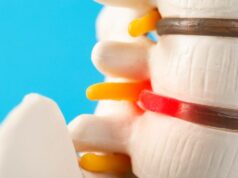
Competitive landscape opens opportunities for Stayble Therapeutics
Almost everyone gets back pain at some point and for some the pain persists for a long time. In about 40 per cent of cases, chronic back pain is due to degenerative disc disease, and it is these patients that Stayble Therapeutics targets with the injection treatment STA363. There are other treatments for degenerative disc disease in development, but none of them treat the root causes of back pain in the same way as Stayble Therapeutics.
Stayble Therapeutics is developing a treatment for discogenic chronic low back pain, also called degenerative disc disease. The disease usually affects people in middle age and leads to long-term back pain and limited mobility and thus a significantly reduced quality of life. The pain is caused by disc degeneration, i.e., age changes in the disc that cause instability in the spinal segment and leakage of proinflammatory substances from the degenerated disc.
The company’s drug candidate is called STA363 and is meant to be injected into the intervertebral disc to convert it into connective tissue. This is expected to stabilize the disc and stop the leakage, which can provide permanent pain relief. STA363 thus treats the root causes of the back pain, unlike existing treatments that only treat the symptoms.
Today’s treatment options – analgesics and physiotherapy or spinal fusion
Today, degenerative disc disease is mainly treated with painkillers in combination with physiotherapy to strengthen the muscles and increase the stability of the lumbar spine. As many as 70 per cent of patients are not sufficiently helped by this and must therefore learn to live with their pain. Very few patients are offered spinal fusion or disc replacement as it is only suitable for those with severe disc degeneration.
There is thus a large therapeutic gap between first-line treatment and the more drastic and expensive surgical procedures. Stayble Therapeutics has identified a demand for treatment options that can be given early in the care process and that are minimally invasive, a demand that STA363 might be able to meet.
Other injection treatments
Anti-inflammatory steroid injections such as cortisone are also given epidurally for pain relief purposes. However, the effect lasts only a few weeks or, in some cases, a couple of months.
In addition, there are intradiscal gels that can be injected into the discs but remain pharmacologically inactive, i.e. without active substance. The gel only restores the lost height and hydration in the disc. One example is Gelstix, which has received market approval in the EU, but lacks convincing efficacy data.
Regenerative drugs in development
Stayble Therapeutics’ primary competitors are other research companies that develop disease-modifying treatments for degenerative disc disease, and in particular companies that develop regenerative drugs in the form of cell therapies.
An example of such a company is Australian Mesoblast, which is in phase III with Rexlemestrocel-L. The drug candidate contains mesenchymal stem cells that are injected into the disc to stop or even reverse the course of the disease. Mesoblast has entered a partnership with Grünenthal in Germany for the development and commercialisation of the candidate in Europe and Latin America, but they have not yet been able to demonstrate that the candidate meets the requirements required for market approval. Earlier this year, results from a phase III study with Rexlemestrocel-L were presented that showed that the primary efficacy endpoint in the study had not been met.
DiscGenics is also developing a cell therapy for disc degeneration. The company is in an early clinical phase with IDCT (rebonuputemcel) containing progenitor cells from the disc. It is also worth mentioning that American Vivex Biologics is developing VIA Disc NP where the intention is to transplant in nucleus pulposus tissue, i.e., tissue from the nucleus of the spinal disc, to support the biomechanical function. Recently published results showed no effect on pain 12 months after treatment.
Challenges with stem cells
According to Stayble Therapeutics, there are some challenges in treating degenerative disc disease with stemcells. First of all, it is now clear that Rexlemestrocel-L treatment (Mesoblast) does not lead to a regeneration ofthe disc nucleus. This have been shown in animal studies, but not in MRI scans in patients. Since Via Disc NP (Vivex Biologics) also has no effect on the structure, one can question the whole hypothesis behind stem cell treatment. In addition, the long-lasting effect is uncertain because the disc will probably continue the degenerative process after the stem cells have been injected since it is a natural part of the aging process.

Interview with Stayble Therapeutics’ CSO
BioStock contacted Anders Lehmann, Stayble Therapeutics’ CSO, to learn more about the competitive landscape. Lehmann has extensive experience in pharmaceutical research and development from his time at AstraZeneca. He has also previously worked in biotech start-ups, co-founded a pharmaceutical company and worked as a consultant.
Anders, who would you say are Stayble Therapeutics’ biggest competitors?
– Stem cell company where Mesoblast has come the furthest.
Mesoblast has presented phase III results for the company’s stem cell treatment for degenerative discdisease. What are your thoughts on the results of the phase III study?
– It has been shown that the candidate has a certain effect on pain, but it is not enough that one can register the product in the case of treatable patients. The effect on disability is even smaller. The effect lasts for a long time, at least 2 years, but the strange thing is that the effect of placebo also lasts for the same amount of time. The design of the study is also remarkable because it compares active treatment (stem cells+hyaluronic acid) with placebo (saline alone, i.e., no hyaluronic acid). This is justified by the assumption that hyaluronic acid has no effect, however, various studies have shown that it may have some effect. So, you could say that you might see greater differences between active and placebo than you would if you had a more relevant placebo, i.e. hyaluronic acid.
– Another important finding is that you do not see any effect on the structure of the disc. The very starting point for stem cell treatment, based on preclinical experiments, is that the disc is “rejuvenated” and has a less degenerate structure. Vixex Biologics has similar results, so it is likely that the whole hypothesis behind stemcell treatment is incorrect. This does not matter to the patient – if you feel better, the mechanism of action does not matter – but the view of stem cell treatment will be modified. It is also not certain that all stem cell companies based on preclinical disc rejuvenation data will see any effect in patients. It all depends on which mechanism is active to reduce pain and how different types of stem cells affect this mechanism.
How does Stayble Therapeutics’ drug candidate STA363 differ from other treatment options fordegenerative disc disease?
– The hypothesis is that STA363 will have a therapeutic effect based on structural change of the disc that has been proven in both preclinical experiments and in patients. As discussed above, stem cell therapy has not ye been shown to have an effect on the structure of the disc. The structural change one wants to achieve with stem cell therapy is different than that of STA363.
»The hypothesis is that STA363 will have a therapeutic effect based on structural change of the disc that has been proven in both preclinical experiments and in patients.«
– In preclinical experiments, the STA363 makes the disc stiffer due to connective tissue transformation documented partly macroscopically, i.e. that you can see it with the naked eye, and partly with MRI. In patients you see the same change in MRI, so it is reasonable to assume that you also have an increased connective tissue transformation and stiffness in humans. It is known that increased stiffness (reduced mobility in the segment) has a therapeutic effect. This is based on the effect of rigid surgeries and indirect evidence in the form of reduced problems at increasing age when the disc spontaneously transforms to connective tissue andcgets stiffer.
– Finally, it can be assumed that an inflamed disc filled with connective tissue will show a lower grade of inflammation which in itself should reduce the pain.
The content of BioStock’s news and analyses is independent but the work of BioStock is to a certain degree financed by life science companies. The above article concerns a company from which BioStock has received financing.


